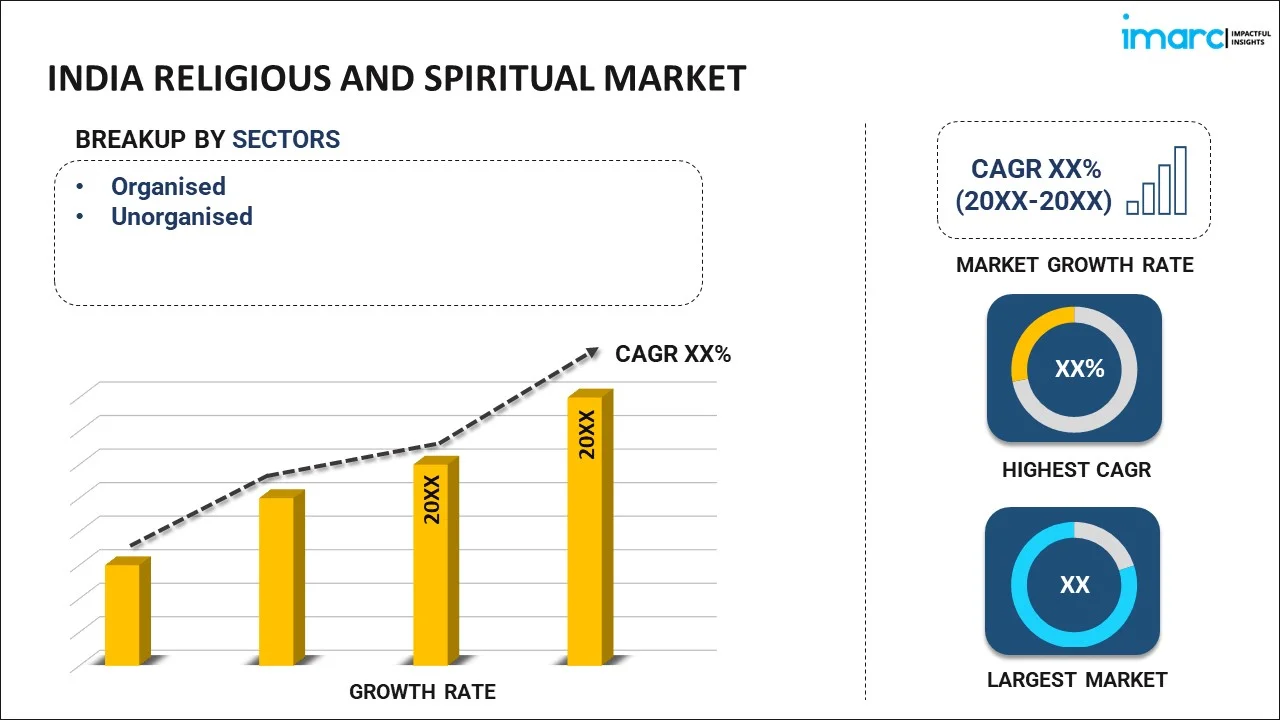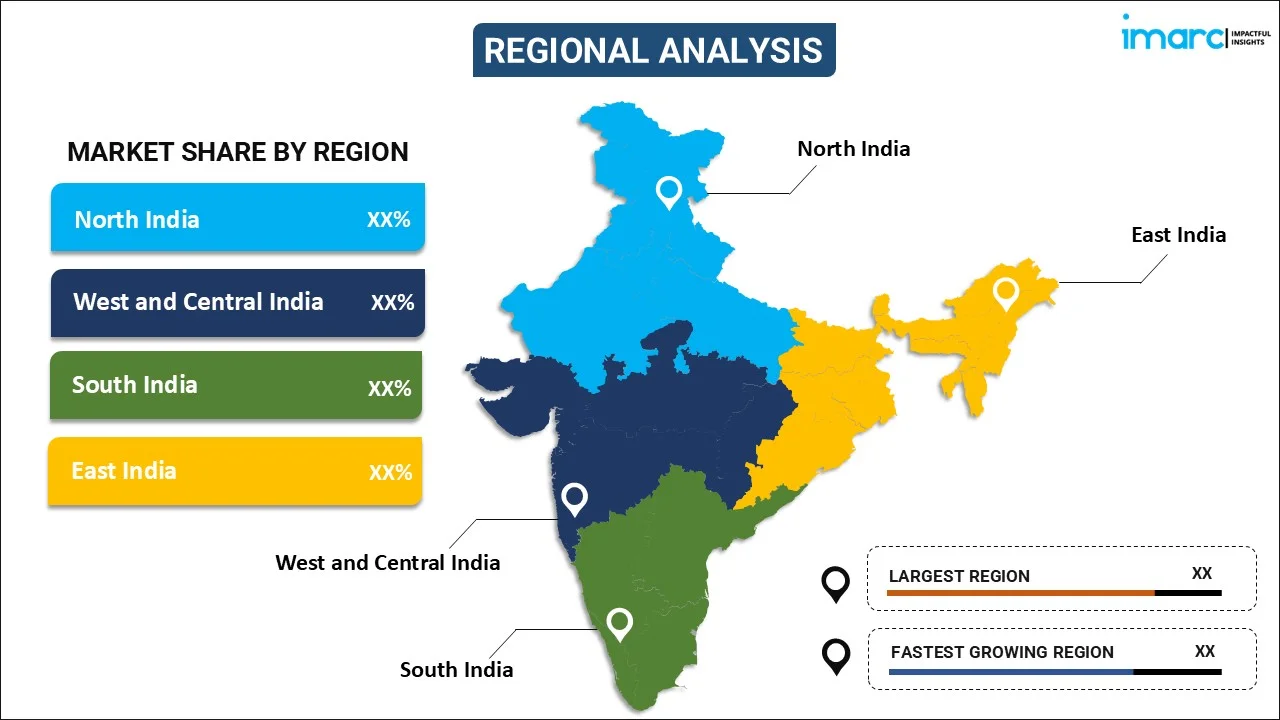
India Religious and Spiritual Market Report by Sector (Organised, Unorganised), Income Source (Religious Tourism, Donations, Media and Music, Religious Items and Merchandise, Construction and Infrastructure, and Others), Distribution Channel (Direct from Religious Places, Retail, Online), Religion (Hinduism, Islam, Sikhism, Buddhism, Christianity, and Others), and Region 2025-2033
Market Overview:
The India religious and spiritual market size reached USD 65.0 Billion in 2024. Looking forward, IMARC Group expects the market to reach USD 135.1 Billion by 2033, exhibiting a growth rate (CAGR) of 7.60% during 2025-2033.
|
Report Attribute
|
Key Statistics
|
|---|---|
|
Base Year
|
2024
|
|
Forecast Years
|
2025-2033
|
|
Historical Years
|
2019-2024
|
|
Market Size in 2024
|
USD 65.0 Billion |
|
Market Forecast in 2033
|
USD 135.1 Billion |
| Market Growth Rate 2025-2033 | 7.60% |
Religion can be defined as an organized belief system consisting of practices related to the worship of a single or multiple supernatural forces. Some of the commonly practiced religious and spiritual beliefs in India include Hinduism, Islam, Sikhism, Buddhism and Christianity. They involve various beliefs, worldviews, texts, revelations, morals and prophecies that portray sacred significance to the members of a particular faith. Individuals also practice sermons, rituals, prayers, meditation and feasts as per their devotion to religious faith. On the other hand, spirituality is an overlapping concept that involves practices and beliefs around the value, connection and meaning of the existence of an individual. It is usually practiced to achieve a positive state of mind with contentment, acceptance and gratitude. Individuals indulge in religious and spiritual tourism, donation drives, books and literature tools, flowers, garlands, candles and incense sticks to practice and propagate their beliefs.
The India religious and spiritual market is primarily driven by the increasing pilgrimage tourism across the country. The Government of India is launching various initiatives and projects, such as pilgrimage rejuvenation and spirituality, heritage augmentation drive (PRASHAD) and heritage city development and augmentation yojana, for promoting the infrastructural development at various heritage sites. These policies aim to provide adequate resources for effective rail, road and water transport systems, network connectivity, information centers, drinking water and renewable power for the enhanced convenience of pilgrims and tourists. In line with this, the increasing consumer preference for incense-based products for religious, spiritual and meditational purposes is also contributing to the growth of the market. Temples, churches and other religious establishments widely use products, such as agarbatti, dhoop and candles, for their daily spiritual and religious regimes. Other factors, including the advent of virtual reality (VR) kiosks to provide an immersive and interactive experience of religious sites to the devotees, are anticipated to drive the market toward growth.
Key Market Segmentation:
IMARC Group provides an analysis of the key trends in each sub-segment of the India religious and spiritual market report, along with forecasts at the country and regional level from 2025-2033. Our report has categorized the market based on sector, income source, distribution channel and religion.
Breakup by Sector:

- Organised
- Unorganised
Breakup by Income Source:
- Religious Tourism
- Donations
- Media and Music
- Religious Items and Merchandise
- Construction and Infrastructure
- Others
Breakup by Distribution Channel:
- Direct from Religious Places
- Retail
- Online
Breakup by Religion:
- Hinduism
- Islam
- Sikhism
- Buddhism
- Christianity
- Others
Breakup by Region:

- North India
- West and Central India
- South India
- East India
Competitive Landscape:
The competitive landscape of the industry has also been examined along with the profiles of the key players.
Report Coverage:
| Report Features | Details |
|---|---|
| Base Year of the Analysis | 2024 |
| Historical Period | 2019-2024 |
| Forecast Period | 2025-2033 |
| Units | Billion USD |
| Segment Coverage | Sector, Income Source, Distribution Channel, Religion, Region |
| Region Covered | North India, West and Central India, South India, East India |
| Customization Scope | 10% Free Customization |
| Post-Sale Analyst Support | 10-12 Weeks |
| Delivery Format | PDF and Excel through Email (We can also provide the editable version of the report in PPT/Word format on special request) |
Key Questions Answered in This Report
We expect the India religious and spiritual market to exhibit a CAGR of 7.60% during 2025-2033.
The rising indulgence of individuals towards religious and spiritual practices to achieve a positive state of mind with contentment, acceptance, and gratitude is primarily driving the India religious and spiritual market.
The sudden outbreak of the COVID-19 pandemic has led to the rising inclination towards worship practices through livestreaming, owing to the temporary closure of various religious and spiritual places across the nation.
Based on the religion, the India religious and spiritual market can be segmented into Hinduism, Islam, Sikhism, Buddhism, Christianity, and others. Currently, Hinduism holds the majority of the total market share.
Need more help?
- Speak to our experienced analysts for insights on the current market scenarios.
- Include additional segments and countries to customize the report as per your requirement.
- Gain an unparalleled competitive advantage in your domain by understanding how to utilize the report and positively impacting your operations and revenue.
- For further assistance, please connect with our analysts.
 Inquire Before Buying
Inquire Before Buying
 Speak to an Analyst
Speak to an Analyst
 Request Brochure
Request Brochure
 Request Customization
Request Customization




.webp)




.webp)












